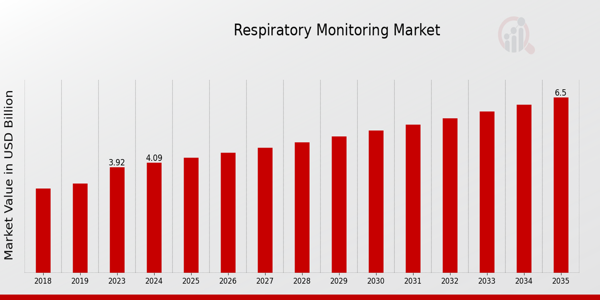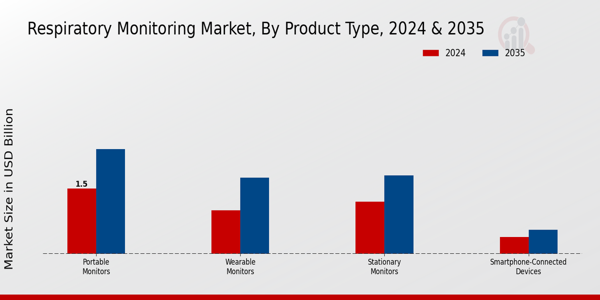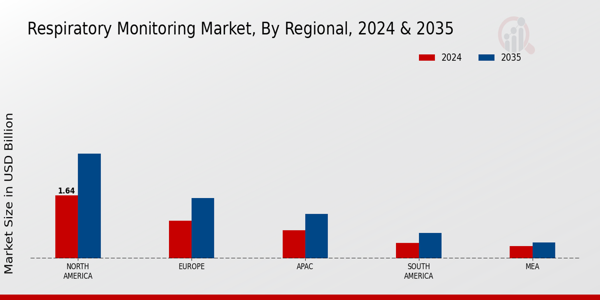Respiratory Monitoring Market Overview
The Respiratory Monitoring Market Size was estimated at 3.92 (USD Billion) in 2023. The Respiratory Monitoring Industry is expected to grow from 4.09(USD Billion) in 2024 to 6.5 (USD Billion) by 2035. The Respiratory Monitoring Market CAGR (growth rate) is expected to be around 4.31% during the forecast period (2025 - 2035).
Key Respiratory Monitoring Market Trends Highlighted
The Global Respiratory Monitoring Market is being propelled by the increasing incidence and prevalence of asthma, chronic obstructive pulmonary disease (COPD), and other simple respiratory disorders. The growing concern for air quality and the rise in the aging population has led to an increased need for sophisticated monitoring solutions that are capable of offering advanced real-time data. As technology continues to progress, wearable sensors and telehealth platforms, such as respiratory monitoring devices, improve patient care and management. The increasing concern for one's respiratory well-being and the rising trend of proactive healthcare are some crucial elements contributing to market growth. This segment has a lot to offer, especially to developing countries with strengthening healthcare systems.
Innovative solutions that leverage artificial intelligence and machine learning for predicting respiratory events could also yield significant benefits. Customizable and portable monitoring devices can cater to a diverse demographic, making respiratory care more accessible. Moreover, partnerships between technology companies and healthcare providers can lead to transformative products, enhancing patient engagement and compliance in managing their respiratory health. Recent trends in this landscape reflect an increasing focus on remote monitoring and patient-centered care models. The COVID-19 pandemic has accelerated the adoption of digital health innovations, further influencing how respiratory conditions are monitored.This shift is prompting healthcare systems to incorporate integrated respiratory management solutions that emphasize continuity of care and data sharing among various stakeholders, including patients, healthcare practitioners, and caregivers. As the landscape evolves, the market is likely to witness significant developments that enable seamless communication and improve health outcomes for individuals with respiratory diseases. The combination of advanced technology and a growing emphasis on proactive health management is shaping the future of the respiratory monitoring market.

Source: Primary Research, Secondary Research, MRFR Database and Analyst Review
Respiratory Monitoring Market Drivers
Rising Prevalence of Respiratory Diseases
The Global Respiratory Monitoring Market Industry is witnessing significant growth driven by the increasing prevalence of respiratory diseases, such as asthma, chronic obstructive pulmonary disease (COPD), and other pulmonary disorders. As the global population ages, the incidence of these diseases is expected to rise, necessitating ongoing monitoring of patients' respiratory health. Improvements in diagnostic technology and an increased awareness of respiratory health among both patients and healthcare providers are pivotal in addressing these issues.Monitoring devices help patients manage their conditions more effectively, thereby reducing hospitalizations and healthcare costs associated with exacerbations. Moreover, with the growth of telemedicine and at-home care, there is a strong demand for respiratory monitoring devices that can be easily utilized by patients in their environments. Technological advancements are leading to the development of more sophisticated and user-friendly monitoring systems, enabling better patient compliance and engagement.Consequently, the increase in respiratory disease prevalence is a primary driving factor for the expansion of the Global Respiratory Monitoring Market. The industry is poised for growth as reliance on innovative monitoring solutions becomes critical in managing these chronic respiratory ailments effectively.
Technological Advancements in Monitoring Devices
Innovation plays a crucial role in driving the Global Respiratory Monitoring Market Industry. The introduction of advanced respiratory monitoring devices, such as portable and wearable technologies, is enhancing the accuracy and efficiency of patient monitoring. These devices can provide real-time data on a patient's respiratory status, allowing healthcare professionals to make timely clinical decisions. Additionally, the integration of artificial intelligence and machine learning into monitoring systems is revolutionizing how respiratory health is assessed and managed.
Increase in Healthcare Expenditure
As healthcare expenditure continues to rise globally, there is more funding available for respiratory health initiatives and technologies. Governments and private sectors are increasingly investing in healthcare infrastructure, which includes respiratory monitoring solutions. This surge in expenditure fosters the development and adoption of innovative healthcare technologies, contributing significantly to the Global Respiratory Monitoring Market Industry.
Respiratory Monitoring Market Segment Insights
Respiratory Monitoring Market Product Type Insights
The Global Respiratory Monitoring Market is poised for significant growth, with various product types catering to the diverse needs of patients and healthcare providers. In this market, Portable Monitors, Wearable Monitors, Stationary Monitors, and Smartphone-Connected Devices play critical roles. The Portable Monitors segment, valued at 1.5 USD Billion in 2024 and projected to reach 2.4 USD Billion by 2035, holds a major portion of the market share. Its importance stems from its flexibility and ease of use, allowing patients to monitor their respiratory health independently, which has become increasingly essential in managing chronic respiratory conditions. Following closely, the Wearable Monitors segment is valued at 1.0 USD Billion in 2024, with an expectation of reaching 1.75 USD Billion by 2035. This segment has gained popularity due to the integration of advanced technology, enabling real-time health tracking, thereby promoting proactive healthcare management. Stationary Monitors are valued at 1.2 USD Billion in 2024, ripe for growth to 1.8 USD Billion by 2035. These devices remain significant in clinical settings where continuous and accurate monitoring is paramount for patients with severe respiratory ailments.
Lastly, the Smartphone-Connected Devices segment, although relatively smaller, demonstrates the potential for growth with a valuation of 0.39 USD Billion in 2024 and is projected to reach 0.55 USD Billion by 2035. These devices leverage the increasing penetration of smartphones and mobile apps to allow users to track their respiratory health conveniently. The collective revenue from these product types illustrates the diverse nature of monitoring solutions available within the Global Respiratory Monitoring Market, reflecting a trend driven by technological advancements and expanding healthcare needs.
Market statistics indicate an evolving landscape wherein the interplay of convenience and technological sophistication continues to redefine the approach to respiratory health management. As healthcare providers increasingly adopt these monitoring technologies, numerous opportunities arise to enhance patient care and outcomes throughout the respiratory monitoring spectrum.

Source: Primary Research, Secondary Research, MRFR Database and Analyst Review
Respiratory Monitoring Market End User Insights
The Global Respiratory Monitoring Market within the End User segment has shown significant growth, particularly as healthcare providers recognize the critical need for effective respiratory management. By 2024, the overall market was valued at 4.09 billion USD, indicating a strong demand for monitoring solutions across various settings. Hospitals play a crucial role in this market, serving as primary facilities for acute respiratory care, while Home Care Settings are becoming increasingly important due to a shift toward at-home patient management.Ambulatory Surgical Centers have also emerged as significant contributors, facilitating outpatient procedures that require efficient respiratory monitoring. Furthermore, Diagnostic Centers are essential for early detection and treatment of respiratory issues, driving demand for advanced monitoring technologies. The combination of these factors showcases the multi-faceted nature of the Global Respiratory Monitoring Market revenue, emphasizing its critical role in improving patient outcomes and enhancing the overall healthcare infrastructure. With ongoing technological advancements and an increasing awareness of respiratory health, market growth is expected to continue steadily, reflecting broader trends and opportunities in the healthcare industry.Overall, the Global Respiratory Monitoring Market statistics indicate a robust ecosystem where various sectors converge to support respiratory health monitoring.
Respiratory Monitoring Market Indication Insights
The Global Respiratory Monitoring Market was valued at 4.09 billion USD by 2024, reflecting a strong growth trajectory driven by increasing respiratory illnesses globally. The segmentation within this market is crucial, particularly concerning chronic conditions like Chronic Obstructive Pulmonary Disease (COPD), which remains a major health concern affecting millions. Asthma is also a significant contributor to the demand for respiratory monitoring solutions, as it requires ongoing management to prevent exacerbations. Pneumonia, with its acute onset, highlights the need for accurate monitoring to ensure timely intervention, while Sleep Apnea represents a growing focus area due to rising awareness and diagnosis rates that propel market growth.The Global Respiratory Monitoring Market revenue is impacted by advancements in monitoring technologies and the increasing prevalence of lifestyle diseases. Additionally, the Global Respiratory Monitoring Market statistics reveal a need for improved healthcare infrastructure to address these prevalent conditions, posing both challenges and opportunities. The market growth is underpinned by innovations that cater specifically to these indications, making them integral to the industry's evolution.
Respiratory Monitoring Market Technology Insights
The Global Respiratory Monitoring Market had a valuation of 4.09 billion USD by 2024 and expand further, driven by technological advancements. Key components shaping the market include Capnometers, Spirometers, Pulse Oximeters, and Electronic Stethoscopes, each playing a crucial role in respiratory health assessment. Capnometers are significant for monitoring carbon dioxide levels, thus aiding in effective respiratory management. Spirometers dominate in diagnosing and managing conditions such as asthma and COPD by measuring lung function.In addition, Pulse Oximeters are widely utilized in both clinical and home settings, providing rapid oxygen saturation levels, reflecting the surge in demand for non-invasive monitoring solutions. Electronic Stethoscopes enhance traditional assessments by integrating digital technology for better acoustic performance and data recording capabilities. Overall, the Global Respiratory Monitoring Market data reflects robust growth fueled by an increasing prevalence of respiratory diseases, growing awareness regarding early diagnosis, and the ongoing shift towards homecare solutions.
Respiratory Monitoring Market Regional Insights
The Global Respiratory Monitoring Market is projected to witness considerable growth across various regions, highlighting the importance of regional segmentation. In 2024, North America led the market with a valuation of 1.636 USD Billion, reflecting its dominant position. The European market follows closely at 0.982 USD Billion, showcasing significant investment and advancements in respiratory technologies. The APAC region is emerging as a crucial growth area, with a value of 0.736 USD Billion, driven by increasing healthcare infrastructure and awareness.South America and MEA present smaller yet important markets, valued at 0.409 USD Billion and 0.327 USD Billion, respectively, indicating growth opportunities in these regions. This landscape illustrates that North America holds the majority share, largely due to its comprehensive healthcare systems and high adoption rates of advanced monitoring solutions. Meanwhile, Europe's focus on regulatory compliance and innovation in respiratory monitoring technologies makes it a key player. The overall Global Respiratory Monitoring Market data suggests an upward trend fueled by technological advancements, increasing incidence of respiratory diseases, and the growing demand for home-based monitoring solutions across these regions.

Source: Primary Research, Secondary Research, MRFR Database and Analyst Review
Respiratory Monitoring Market Key Players and Competitive Insights
The Global Respiratory Monitoring Market has witnessed significant advancements and growth over the years, with various players contributing to its dynamic landscape. Competitive insights within this market reflect the endeavor of companies to innovate and differentiate their products in response to an increasing demand for advanced respiratory monitoring solutions. Factors including the rise in respiratory diseases, aging populations, and technological advancements have fueled competition, with firms striving to deliver effective and reliable monitoring devices. The market is characterized by various established players as well as emerging companies, all aiming to enhance patient outcomes through improved monitoring capabilities and solutions. As players adopt strategies such as mergers and acquisitions, product launches, and collaborations, the landscape is evolving with a focus on integrated healthcare solutions that cater to both clinical and at-home environments.Respironics has established a notable presence within the Global Respiratory Monitoring Market, recognized for its commitment to providing innovative and tailored respiratory solutions. The company leverages cutting-edge technology and research to develop high-quality products that address various respiratory conditions with precision. Respironics is particularly known for its user-friendly and effective respiratory monitoring devices that enhance patient comfort and accuracy in monitoring respiratory health. The company's strengths lie in its robust product portfolio, which includes advanced sleep therapy solutions and ventilators. Additionally, Respironics benefits from a strong distribution network and a dedicated customer support system, which aids in building strong relationships with healthcare providers and patients alike. Through its ongoing commitment to innovation and quality, Respironics continues to solidify its position as a leader in the respiratory monitoring segment.Smiths Medical, another key player in the Global Respiratory Monitoring Market, has successfully positioned itself by focusing on the critical needs of healthcare providers and patients. The company specializes in a wide range of medical devices, including respiratory monitoring solutions that cater to various healthcare settings. Smiths Medical boasts a strong reputation for reliability and performance, emphasizing the importance of quality in its product offerings. The company's strengths are further enhanced by its dedication to research and development, which enables it to bring forth advanced products that meet evolving healthcare demands. With a focus on user-centric design, Smiths Medical's devices aim to streamline the respiratory monitoring process, ensuring accuracy and efficiency. Additionally, their comprehensive training and support for healthcare professionals help strengthen their market presence and foster trust among users. Overall, Smiths Medical continues to leverage its expertise in respiratory monitoring to maintain a competitive edge in the marketplace.
Key Companies in the Respiratory Monitoring Market Include
- Respironics
- Smiths Medical
- Dragerwerk
- FMC Corporation
- Proformer
- Honeywell
- Advance Medical Reviews
- Nihon Kohden Corporation
- Philips
- Mindray
- Zoll Medical
- Cardinal Health
- GE Healthcare
- Medtronic
- Masimo
Respiratory Monitoring Market Industry Developments
The Global Respiratory Monitoring Market has seen significant developments recently, particularly amid the ongoing advances in healthcare technology. Companies like Philips and Medtronic are enhancing their product offerings with innovative respiratory monitoring devices that leverage artificial intelligence for improved patient outcomes. In terms of mergers and acquisitions, Respironics has been strengthening its market position through strategic partnerships, while Honeywell and Dragerwerk are aligning resources to expand their product portfolios. Smiths Medical has also been active, focusing on enhancing its respiratory devices to meet rising demand. The market valuation of key players such as GE Healthcare and Zoll Medical has seen a noticeable uptick, influenced by the growing emphasis on remote patient monitoring and the increasing prevalence of respiratory diseases globally. Moreover, the pandemic has amplified the demand for effective respiratory monitoring technologies, propelling companies to innovate and adapt rapidly. Amidst this dynamic environment, companies like Nihon Kohden Corporation and Mindray are expanding their global reach, driving competition and investment within the sector, thereby reshaping the landscape of respiratory monitoring on a global scale.
Respiratory Monitoring Market Segmentation Insights
Respiratory Monitoring Market Product Type Outlook
- Portable Monitors
- Wearable Monitors
- Stationary Monitors
- Smartphone-Connected Devices
Respiratory Monitoring Market End User Outlook
- Hospitals
- Home Care Settings
- Ambulatory Surgical Centers
- Diagnostic Centers
Respiratory Monitoring Market Indication Outlook
- Chronic Obstructive Pulmonary Disease
- Asthma
- Pneumonia
- Sleep Apnea
Respiratory Monitoring Market Technology Outlook
- Capnometers
- Spirometers
- Pulse Oximeters
- Electronic Stethoscopes
Respiratory Monitoring Market Regional Outlook
- North America
- Europe
- South America
- Asia-Pacific
- Middle East and Africa
| Attribute/Metric Source: |
Details |
| MARKET SIZE 2023 |
3.92(USD Billion) |
| MARKET SIZE 2024 |
4.09(USD Billion) |
| MARKET SIZE 2035 |
6.5(USD Billion) |
| COMPOUND ANNUAL GROWTH RATE (CAGR) |
4.31% (2025 - 2035) |
| REPORT COVERAGE |
Revenue Forecast, Competitive Landscape, Growth Factors, and Trends |
| BASE YEAR |
2024 |
| MARKET FORECAST PERIOD |
2025 - 2035 |
| HISTORICAL DATA |
2019 - 2024 |
| MARKET FORECAST UNITS |
USD Billion |
| KEY COMPANIES PROFILED |
Respironics, Smiths Medical, Dragerwerk, FMC Corporation, Proformer, Honeywell, Advance Medical Reviews, Nihon Kohden Corporation, Philips, Mindray, Zoll Medical, Cardinal Health, GE Healthcare, Medtronic, Masimo |
| SEGMENTS COVERED |
Product Type, End User, Indication, Technology, Regional |
| KEY MARKET OPPORTUNITIES |
Telemedicine integration growth, Wearable respiratory devices demand, Increased prevalence of respiratory diseases, Advancements in AI diagnostics, Home-based monitoring solutions expansion |
| KEY MARKET DYNAMICS |
Increasing prevalence of respiratory diseases, Technological advancements in monitoring devices, Rising geriatric population, Growing awareness of respiratory health, Supportive government initiatives and funding |
| COUNTRIES COVERED |
North America, Europe, APAC, South America, MEA |
Frequently Asked Questions (FAQ) :
The Global Respiratory Monitoring Market is expected to be valued at 4.09 USD Billion in 2024.
By 2035, the Global Respiratory Monitoring Market is anticipated to reach a value of 6.5 USD Billion.
The expected CAGR for the Global Respiratory Monitoring Market from 2025 to 2035 is 4.31%.
The major product segments include Portable Monitors, Wearable Monitors, Stationary Monitors, and Smartphone-Connected Devices.
In 2024, North America holds the largest market share in the Global Respiratory Monitoring Market, valued at 1.636 USD Billion.
The market size for Portable Monitors in 2024 is estimated to be 1.5 USD Billion.
The Wearable Monitors segment is projected to grow to 1.75 USD Billion by 2035.
Key players in the market include Respironics, Smiths Medical, Dragerwerk, and Philips among others.
The expected market value for Smartphone-Connected Devices is projected to reach 0.55 USD Billion by 2035.
The APAC region is expected to grow to 1.152 USD Billion in market value by 2035.
The Global Respiratory Monitoring Market is expected to be valued at 2.13 USD Billion in 2024.
By 2035, the Global Respiratory Monitoring Market is projected to reach 3.5 USD Billion.
The expected CAGR for the Global Respiratory Monitoring Market from 2025 to 2035 is 4.62%.
North America is anticipated to dominate the market with a value of 0.85 USD Billion in 2024.
Europe's market size is projected to be 0.7 USD Billion in 2024.
The expected market size for the APAC region in 2024 is 0.45 USD Billion.
Major players in the market include Cardinal Health, Thermo Fisher Scientific, ResMed, and GE Healthcare.
The market size for wearable devices in 2024 is estimated to be 0.6 USD Billion.
Potential challenges may include regulatory hurdles and technological integration in existing healthcare systems.
Emerging trends in digital health and increasing focus on remote patient monitoring present significant opportunities.

















